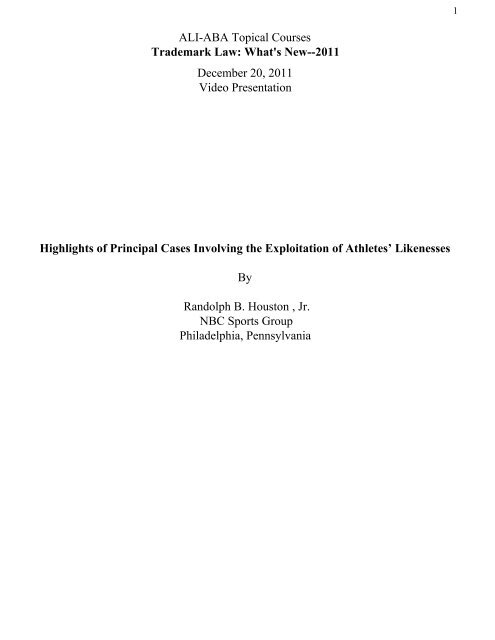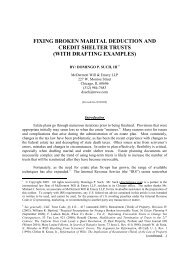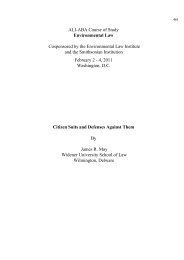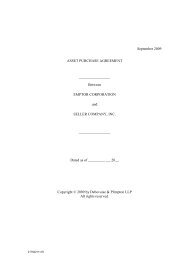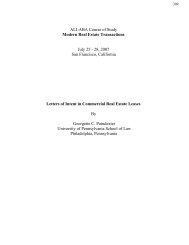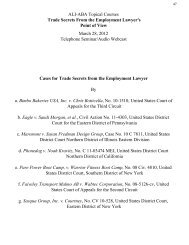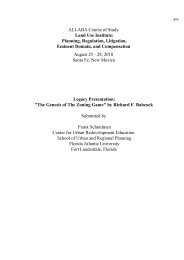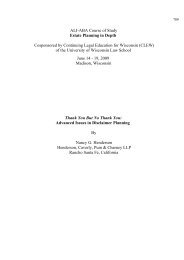ALI-ABA Topical Courses Trademark Law: What's New ... - ALI CLE
ALI-ABA Topical Courses Trademark Law: What's New ... - ALI CLE
ALI-ABA Topical Courses Trademark Law: What's New ... - ALI CLE
Create successful ePaper yourself
Turn your PDF publications into a flip-book with our unique Google optimized e-Paper software.
1<strong>ALI</strong>-<strong>ABA</strong> <strong>Topical</strong> <strong>Courses</strong><strong>Trademark</strong> <strong>Law</strong>: <strong>What's</strong> <strong>New</strong>--2011December 20, 2011Video PresentationHighlights of Principal Cases Involving the Exploitation of Athletes’ LikenessesByRandolph B. Houston , Jr.NBC Sports GroupPhiladelphia, Pennsylvania
2Highlights of Principal Cases Involving theExploitation of Athletes’ Likenessesfor“<strong>Trademark</strong> <strong>Law</strong>: <strong>What's</strong> <strong>New</strong>—2011”<strong>ALI</strong>-<strong>ABA</strong> Live Telecast: Tuesday, December 20, 2011compiled byRandolph B. Houston, Jr.Senior Counsel, Business and Legal AffairsCOMCAST SPORTS GROUP(part of The NBC Sports Group)One Comcast CenterPhiladelphia, PA 19103rhouston@comcastsportsnet.com
3Brown v. Electronic ArtsNFL Hall of Famer Jim Brown is in the midst of an overtime legal battle against ElectronicArts (“EA”), the maker of the popular Madden NFL video game, as a result of EA’sinclusion of a player that allegedly resembled Brown in various editions of Madden NFL ontwo “historic” teams: the 1964-65 Cleveland Browns and the All Browns team. But whatstarted as a set piece between a media titan and a football legend has turned into a FirstAmendment rumble. Parties as diverse as the American Association of Publishers, Viacom,ESPN and the Comic Book Legal Defense Fund, among other parties, are seeking to weighin on the implications of the lawsuit, and put this dispute into the larger context of similarlawsuits brought by athletes alleging that video games have violated their rights relating totheir celebrity status under various legal theories.The lawsuit kicked off in July 2009, when Brown brought suit against EA in the UnitedStates District Court for the Central District of California. Brown claimed that by including aplayer that resembled him in the Madden NFL game without a licensing agreement, EAviolated Section 43(a) of the federal Lanham Act, under a theory of false endorsement, andCalifornia state laws on invasion of privacy and unfair business practices. Although thecharacter who purportedly represents Brown in Madden NFL wears jersey number 37(Brown wore number 32) and the facial image was purportedly scrambled by EA, Brownalleges that the statistics for the running back on the Madden NFL 1964-65 ClevelandBrowns are nearly identical to his own and the changes to the image were merely superficialand nowhere near enough to transform the image of Brown.The district court tackled Brown for a loss and granted EA’s motion to dismiss Brown’sLanham Act count on September 23, 2009, relying heavily on EA’s First Amendmentdefense. In case you misplaced your intellectual property playbook, when a celebrity brings afalse endorsement claim under Lanham Act Section 43(a), the celebrity is likely alleging thathis “celebrity persona” functions as the “mark” that was allegedly misused. Although EAmaintained that it did not misuse Brown’s celebrity persona or likeness, the court ultimatelydismissed the claim based on the First Amendment’s complete defense to a Lanham Actfalse endorsement claim.As a threshold matter, before the court could consider the First Amendment defense, it heldthat video games, and specifically Madden NFL, are a form of expression protected by theFirst Amendment. Next, to evaluate Brown’s Lanham Act claim in light of the FirstAmendment’s protections, the court employed the Second Circuit’s two-pronged Rogers v.Grimaldi test, under which a Lanham Act claim asserted against the creator of the expressivework can succeed only if the public interest in avoiding confusion outweighs the publicinterest in free expression. The first prong of the test requires that the creator’s use of thesubject trademark (his “persona”) must be relevant to the underlying work, in this case, theMadden NFL game. The court easily tackled this issue and held that the first prong wassatisfied because the “[u]se of a legendary NFL player’s likeness in a game about NFLfootball is clearly relevant,” even viewing all factual allegations in the light most favorable toBrown.
4Although the first prong was easily satisfied, the second prong was a tougher play: Brownhad to show that EA’s use of the trademark explicitly misled consumers about the source orcontent of the work. Putting the second prong into context, the court stated that the relevantinquiry is whether people playing Madden NFL would be misled into thinking that Brown issomehow behind the game or is a sponsor of the product. The court held that, since neitherBrown nor his name or likeness are depicted on the game’s packaging or advertising, and hisvirtual athlete is anonymous and identifiable only by jersey number, it would require a “leapof logic” to conclude that the anonymous, misnumbered player’s presence in the gamesequates to Brown’s endorsement or an explicit attempt to convince consumers of hisendorsement. Thus, the court concluded that the second prong of the Rogers test was notmet, and Brown’s Lanham Act claim was barred by the First Amendment’s protection ofexpressive works.To further jump on the pile, because Brown’s Lanham Act claim did not survive thedismissal motion, the court declined to exercise supplemental jurisdiction over Brown’sremaining state and common law claims, since the district court no longer had a “hook” oforiginal jurisdiction for which to hang the supplemental jurisdiction.On July 6, 2010, Brown called for an instant replay review, and filed his appeal of the districtcourt’s decision with the United States Court of Appeals for the Ninth Circuit. Brown’sbrief, among other points, argues that the district court erred because in holding that thesecond prong of the Rogers test was not satisfied (i.e., that there were no explicitrepresentations of endorsement to cause consumer confusion), the court made its ownfinding of fact, and the issue should have been a matter for discovery. The brief also arguesthat EA’s misappropriation is actionable under every trademark-versus-free-speech approachadopted by the Ninth Circuit, including the Rogers test.EA went on the offensive and filed its answering brief on September 20, 2010, urging theNinth Circuit to affirm the dismissal order and reiterating most of the district courtarguments, including the application of the Rogers test. EA argued that if the court acceptsthe arguments in Brown’s briefs, “a broad range of expressive works might be subject toLanham Act claims,” and further urged the court not to turn trademark law into a “weaponfor prominent individuals to restrain the use of their name or likeness in expressive works.”- from Three Point Shot, “Illegal Procedure? Jim Brown Flags Electronic Arts forMisappropriation in Video Game,” November 2010, © 2010 Proskauer Rose LLPThe Brown case has been consolidated with the Keller case (below) on appeal to the Ninth Circuit Court ofAppeals. Oral argument was heard in both cases in February 2011 and a ruling on the appeal isforthcoming.
5Hart v. Electronic ArtsOn Sept. 9, 2011, Judge Freda Wolfson of the United States District Court for the district of<strong>New</strong> Jersey issued a 67 page opinion that is not only the latest in a series of decisionsinvolving Electronic Arts’ (EA) sports video games but is also a significant contribution tothe law on the interplay between the First Amendment and the right of publicity. In Hart v.Electronic Arts, Inc., Civil Action 09-cv-5990, Judge Wolfson granted summary judgment forEA on the claims of a putative class of NCAA football players that EA had misappropriatedtheir likeness and identity for a commercial purpose in violation of <strong>New</strong> Jersey law. TheCourt found that defendant’s First Amendment right to free expression outweighedplaintiff’s right of publicity.Plaintiff Ryan Hart, a former quarterback for Rutgers University, had brought suit inSuperior Court, <strong>New</strong> Jersey on behalf of himself and others similarly situated alleging, interalia, that EA had violated his right of publicity by misappropriating his likeness as a virtualplayer in four editions of EA’s NCAA Football video game. After EA removed to FederalCourt, it moved to dismiss. Judge Wolfson granted the motion, but gave Hart leave to file anamended complaint to allege additional facts in support of his right of publicity claim.The amended complaint alleged that EA misappropriated Hart’s likeness by including inseveral editions of the game a virtual Rutgers player from his home state, bearing his jerseynumber, incorporating his physical attributes (such as height, weight, hair color and style)and preferences (wrist band, helmet visor), as well as his skills (such as his speed and agilityrating and passing accuracy, all derived from his published season statistics). Hart argued thatthe games’ commercial value derived from the wholesale appropriation of the individualplayers’ identity and the resulting “realism” of the games. He further argued that the use of aphotograph of Hart in a photomontage in the game constituted an unauthorizedpromotional use of his image.Solely for purposes of its summary judgment motion, EA conceded that it used Hart’slikeness within certain versions of NCAA Football. It argued, however, that as expressivespeech, the games should be afforded full First Amendment protection, which hereoutweighed the plaintiff’s publicity interests.The Court agreed. In an especially thorough and scholarly opinion, the Court began bywalking through the distinction between commercial and expressive speech and, relying onthe recent Supreme Court decision in Brown v. Entertainment Merchants Ass’n 1 , concluded thatthe games, like other forms of entertainment, were expressive. The photograph did notconstitute promotion or advertising “because this photograph is part of the video gameitself, the commercial transaction has already taken place.” To determine whether the FirstAmendment trumped Hart’s <strong>New</strong> Jersey common law right of publicity, the Court examinedthe origin and development of the right of publicity, <strong>New</strong> Jersey’s adoption of theRestatement (Second) of Torts, the shift from a right-of-privacy-based tort to a propertybasedone, and the history of the application of the First Amendment to the right ofpublicity, leading to the various tests that courts have employed across the country tobalance those competing interests. The primary tests, and those examined at length by Judge
6Wolfson, are the transformative test, urged in his papers by Hart, and the Rogers test,advocated by EA, and it is here that the decision makes its greatest contribution to this areaof the law. Although expressing a preference for the transformative test because “it bestencapsulates the type of nuanced analysis required to properly balance the competing . . .interest[s],” the Court found that EA prevailed under either test.The Court explained that the transformative test, which has its origins in the fair use analysisof copyright law and has been applied in a number of jurisdictions, looks to the extent thatthe likeness has been transformed by expressive changes or additions in the new work, or, inthe words of the California Supreme Court, whether “the celebrity likeness is one of the ‘rawmaterials’ from which an original work is synthesized, or whether the depiction of thecelebrity is the very sum and substance of the work in question." 2 Reviewing recent casesapplying the transformative test, including to videogames, the Court concluded that EA’s useof plaintiff’s likeness was transformative. 3 Although the game structure begins with an avatarthat incorporates many elements of Hart’s likeness and that of other college players, EAdesigners added many interactive expressive features that create a new work out of thatlikeness, including virtual stadiums, coaches, fans, sound effects, music and commentary.Key to the Court’s decision was that the game permits users to alter many of the players’physical characteristics and skills, change the composition of teams, and determine theoutcome of individual games and the entire season in a multitude of different ways. Thisinteractive element is what distinguishes NCAA Football from the works at issue in othercases that have failed the transformative test.The Court went out of its way to address the contrary holding in Keller v. Electronic Arts, Inc. 4a putative class action involving the same series of video games. There, denying EA’s motionto dismiss under California’s anti-SLAPP statute, the district court for the Northern Districtof California held that NCAA Football was not sufficiently transformative. Noting that thepresent motion for summary judgment embraced a broader factual record, Judge Wolfsoncriticized the Keller court’s failure to take into account the expressive nature of the interactivefeatures of the game and its overly narrow focus on the alleged likeness alone instead of thegame as a whole. “[I]n my view, it is logically inconsistent to consider the setting in whichthe character sits, which Keller does in its analysis, yet ignore the remainder of the game.”The Rogers test, developed by the Second Circuit in Rogers v. Grimaldi, was derived fromprotections against false endorsement under the Lanham Act, and has been applied to anumber of right of publicity claims in that and other circuits. In essence, the test askswhether the challenged work is wholly unrelated to the underlying work or whether the useof the plaintiff’s name or likeness is a disguised commercial advertisement. Although JudgeWolfson praised the clarity of its application, she questioned whether a test derived fromtrademark law was properly applicable to a right of publicity claim and whether it struck theright balance between the competing interests. Nonetheless, applying the test to the facts atissue, Hart’s image was clearly not wholly unrelated to NCAA Football, nor was itsincorporation into the game a “disguised commercial advertisement” indicating hisendorsement or creative input. Summary judgment was therefore appropriate under this testas well.
7This decision appears while the appeal of the Keller decision is still pending before the NinthCircuit. It remains to be seen whether Judge Wolfson’s thorough analysis of the issues willbe reflected in the Ninth Circuit’s decision.- from First Amendment Defeats Right of Publicity Claims Against Electronic Arts’NCAA Football Video Games, by Elizabeth A. McNamara, Christopher J. Robinson,and Samuel M. Bayard, September 12, 2011, © 2011 Davis Wright Tremaine LLPKeller v. Electronic ArtsCourt denies video game developer’s motion to dismiss former college football player’s rightof publicity claims, rejecting developer’s argument that its use of players' physicalcharacteristics and jersey numbers is protected by First Amendment or public interestdefense; court also dismisses Indiana right of publicity claim against NCAA for “knowinglyapprov[ing]” video game developer’s use of plaintiff's likeness.Plaintiff is a former starting quarterback for Arizona State University and the University ofNebraska. Electronic Arts (EA) developed the “NCAA Football” series of video games. Inthe games, consumers can simulate football matches between college and university teams.Plaintiff alleged that EA designed the virtual football players to resemble real-life collegefootball athletes, including himself, by using the same jersey numbers, physical characteristicssuch as height and weight, and home states.Plaintiff filed suit against EA, National Collegiate Athletic Association (NCAA), andCollegiate Licensing Company (CLC). Plaintiff alleged that NCAA violated Indiana’s right ofpublicity statute when it “knowingly approved” EA’s use of plaintiff’s likeness. NCAAresponded that plaintiff’s claim should fail because he did not allege that NCAA actuallyused his image or likeness. Under Indiana law, “[a] person may not use an aspect of apersonality's right of publicity for a commercial purpose during the personality’s lifetime orfor one hundred (100) years after the date of the personality's death without having obtainedprevious written consent from a person . . . .” Indiana Code § 32-36-1-8. The court held thatthe plain language of the statute favors NCAA’s position. “Plaintiff argues that NCAA’sliability under Indiana law arises from its knowing approval of EA’s use of his likeness. Thisinterpretation expands liability under the Indiana statute to include persons who enable rightof publicity violations. . . . The court declines to adopt plaintiff’s interpretation.”The court also rejected plaintiff’s argument that NCAA should be held liable under Indiana’sright of publicity statute as a co-conspirator of EA, which used his likeness, because plaintiffdid not allege that either EA or CLC, the alleged co-conspirators, violated Indiana right ofpublicity law. The court accordingly dismissed the claim for violating Indiana’s right ofpublicity law against NCAA, but granted plaintiff leave to amend to allege that NCAA usedhis likeness or conspired with others to violate his right of publicity under Indiana law.
8Plaintiff alleged that EA violated California statutory and common law right of publicity.California’s right of publicity statute provides, “Any person who knowingly uses another’sname, voice, signature, photograph, or likeness, in any manner, on or in products,merchandise, or goods, or for purposes of advertising or selling, or soliciting purchases of,products, merchandise, goods or services, without such person’s prior consent . . . shall beliable for any damages sustained by the person or persons injured as a result thereof.” Cal.Civ. Code § 3344(a). According to the court, the statutory right of publicity complements thecommon law right of publicity, which arises from the misappropriation tort derived from thelaw of privacy. To state a claim under California common law, a plaintiff must allege “‘(1)the defendant’s use of the plaintiff’s identity; (2) the appropriation of plaintiff’s name orlikeness to defendant’s advantage, commercially or otherwise; (3) lack of consent; and (4)resulting injury.’” Hilton v. Hallmark Cards, 580 F.3d 874 (9th Cir. 2009) (quoting Downingv. Abercrombie & Fitch, 265 F.3d 994 (9th Cir. 2001)).EA argued that plaintiff’s California right of publicity claims are barred by the FirstAmendment and California law. The court rejected these arguments and denied EA’s motionto dismiss the California right of publicity claims.The court explained that a defendant may raise an affirmative defense that the challengedwork is “protected by the First Amendment inasmuch as it contains significanttransformative elements or that the value of the work does not derive primarily from thecelebrity’s fame” citing Hilton, 580 F.3d at 889. The court discussed Comedy III Prods., Inc.v. Saderup, 25 Cal. 4th 387 (2001), in which the California Supreme Court held thatdefendant’s “literal, conventional depictions of The Three Stooges,” drawn in charcoal andprinted on tee-shirts, did not contain transformative elements that warranted protection bythe First Amendment, and Winter v. DC Comics, 30 Cal. 4th 881 (2003), in which the samecourt held that a comic book depiction of Johnny and Edgar Winter as half-human, halfwormcartoon characters was sufficiently transformative.In this case, the court held that EA’s depiction of plaintiff in “NCAA Football” is notsufficiently transformative to bar his California right of publicity claims as a matter of law.“In the game, the quarterback for Arizona State University shares many of plaintiff’scharacteristics. For example, the virtual player wears the same jersey number, is the sameheight and weight and hails from the same state. EA’s depiction of plaintiff is far from thetransmogrification of the Winter brothers. EA does not depict plaintiff in a different form;he is represented as he what he was: the starting quarterback for Arizona State University[and] the game’s setting is identical to where the public found plaintiff during his collegiatecareer: on the football field.” The court also rejected EA’s argument that the court shouldconsider the transformative elements of the video game as a whole, noting that such a viewis not supported by precedent, and stating that the court’s focus must be on the depiction ofthe plaintiff, not the game’s other elements.The court then addressed EA’s public interest defense. According to the court, underCalifornia law no cause of action will lie for the publication of matters in the public interest.The court distinguished this case from Gionfriddo v. Major League Baseball, 94 Cal. App.4th 400 (2001),where the court held that the defendants, who operated a website that
9reported historical baseball team rosters and listed names of players who won awards duringeach season, were entitled to the public interest defense, and Montana v. San Jose Mercury<strong>New</strong>s, Inc., 34 Cal. App. 4th 790 (1995), where the court applied the public interest defenseto defendant newspaper’s posters containing reproductions of newspaper pages reporting onthe San Francisco 49ers’ win in the 1990 Super Bowl.The court held that “NCAA Football” is unlike the works in Gionfriddo and Montana. “Thegame does not merely report or publish plaintiff’s statistics and abilities. On the contrary,EA enables the consumer to assume the identity of various student athletes and compete insimulated college football matches. EA is correct that products created for entertainmentdeserve constitutional protection. But it does not follow that these protections are absoluteand always trump the right of publicity.” (Citations omitted.)The court also rejected EA’s argument that its use fell within the exemption provided byCalifornia Civil Code section 3344(d) which exempts from liability “a use of a name . . . orlikeness in connection with any news, public affairs, or sports broadcast or account, or anypolitical campaign.” The court held that section 3344(d) requires the same type of activity asthe public interest defense, namely reporting, and that although “NCAA Football” is basedon subject matter considered “public affairs,” EA is not entitled to the statutory defense“because its use of plaintiff’s image and likeness extends beyond reporting informationabout him.”The court also denied defendants’ motion to dismiss the civil conspiracy claim, grantedNCAA’s motion to dismiss the breach of contract claim with leave to amend, and deniedEA’s motion to strike under California’s Anti-SLAPP statute.- by Jonathan Zavin, February 17, 2010, © 2010 Loeb & Loeb LLPThe Keller case has been consolidated with the Brown case (above) on appeal to the Ninth Circuit Court ofAppeals. Oral argument was heard in both cases in February 2011 and a ruling on the appeal isforthcoming.Davis v. Electronic ArtsA class action lawsuit has been filed against Electronic Arts, Inc. (“Electronic Arts” or“Defendant”) in the United States District Court for the Northern District of California(styled Michael E. Davis and Tony Davis v. Electronic Arts, Inc., Case No. 3:10-cv-03328-JL)alleging, among other things, that Electronic Arts unlawfully uses retired NFL footballplayers’ likenesses on historic NFL teams in Electronic Arts’ or EA’s Madden NFL videogame without the NFL players’ permission or authorization, according to a class actionlawsuit news report.The Electronic Arts EA Madden NFL video game class action lawsuit complaint isreportedly brought on behalf of approximately 6000 retired NFL players whose likeness
10were included in an historic team in all versions and editions of the Madden NFL videogame sold since July 29, 2008, without permission or authorization.The Electronic Arts EA Madden NFL video game class action complaint reportedly allegesthat the only significant detail that EA changes from the real-life retired NFL player is theNFL players’ jersey number and that the video games is allegedly designed so that consumersof the Madden NFL game have no difficulty identifying who the historic players are (forexample, by position, years in the NFL, weight and height, relative skill level in differentaspects of the game, etc.).- from “Electronic Arts Class Action <strong>Law</strong>suit Filed Over EA’s Alleged Use Of RetiredNFL Players’ Likenesses In EA’s Madden NFL Video Game,” August 3, 2010, ©2010 Class Action <strong>Law</strong>suits In The <strong>New</strong>sO’Bannon v. NCAA[F]ormer UCLA power forward Ed O’Bannon is adding a new play to the book, which maymake it possible for former college athletes to get a slice of the licensing pie. After seeing afriend’s child playing a video game featuring classic teams, including the 1995 Bruins, andwith encouragement from Sonny Vaccaro, O’Bannon found himself wondering why he wasnot entitled to a share of the related revenues for the use of his likeness. In July 2009, theerstwhile first-round NBA draft pick filed his own class action lawsuit – O’Bannon v. NationalCollegiate Athletic Association and Collegiate Licensing Company – in the same court as Keller onbehalf of a narrower class than the one named in the Keller action. In O’Bannon, the allegedclass is limited to former student athletes who competed on Division I men’s basketballteams and Football Bowl Subdivision (formerly known as Division I-A) men’s footballteams. O’Bannon charges the NCAA and CLC with a broad slew of misuses of formerplayers’ indicia of identity beyond the gaming world, into “television contracts, rebroadcastsof ‘classic’ games, DVD game and highlight film sales and rentals, ‘stock footage’ sales tocorporate advertisers and others, photograph sales . . . and jersey and other apparel sales….”Importantly, rather than bring suit claiming violation of the right of publicity, O’Bannonalleges violations of antitrust law. According to O’Bannon, the NCAA and CLC areunreasonably restraining trade within the $4 billion annual market for collegiate licensedmerchandise. O’Bannon seeks an accounting of the defendants’ finances and to establish aconstructive trust that would hold the licensing revenues, which current college athletes –who are not permitted to be paid for their play to preserve amateurism – could access uponleaving college. The crux of O’Bannon’s complaint rests on Form 08-3a, a document thatthe NCAA requires prospective student athletes to sign in order to be eligible to play.According to O’Bannon, Form 08-3a is a “contract of adhesion” that requires young athletesto release in perpetuity their right to economically exploit their persona in connection withtheir collegiate athletic career and transfers this right to the NCAA’s or its third-partydesignees, who can use the student athlete’s name or picture to promote NCAA events,activities or programs.
11The complaint goes on to allege that Form 08-3a, read together with NCAA Bylaw 12.5.1.1,allows the NCAA and third parties to license student athletes’ indicia of identity andeffectively blocks student athletes from participating at all in the collegiate licensingmarketplace. According to O’Bannon, there are less restrictive means than the NCAA’scurrent policy, including as an example the group licensing programs established inprofessional sports leagues that enable the sharing of monies between players and teams.On January 2010, the District Court for the Northern District of California consolidated theKeller and O’Bannon cases and, in February, it denied part of the NCAA’s motion to dismissO’Bannon’s case. The district court found that O’Bannon had pleaded enough facts to moveforward on his antitrust theory. The court also found the licensing agreements at issue in thecase to be vertical restraints (and not horizontal restraints between direct competitors) andtherefore more appropriately analyzed under the “rule of reason” versus being “per se”illegal. The court also ruled that O’Bannon successfully identified a market – the collegiatelicensing market – and pleaded sufficient facts to support a claim that the defendants’actions result in a decrease in the number of competitors in that market. In the same order,the court dismissed a related case brought by Craig <strong>New</strong>some for failure to plead a relevantmarket. On March 10, O’Bannon and Keller filed an amended complaint that added 11additional plaintiffs, including Harry Flournoy, who was captain of the 1966 Texas Westernteam that defeated the University of Kentucky and was immortalized in the film Glory Road,and Eric Riley, who played at the University of Michigan with Chris Weber and the Fab 5.In a separate ruling, the district court also ruled that the First Amendment did not protectEA’s use of players’ identities in video games, finding that such use is not sufficientlytransformative nor a matter of public interest. Though EA purposefully leaves player namesoff jerseys in its games depicting collegiate athletes, gamers are able to download teamrosters that impose player names on the jerseys.- from Three Point Shot, “Pay Me If You Want To Play Me, Part II: Former Player ofthe Year Ed O’Bannon Gains Ground in Suit Relating to Use of Image,” April 2010,© 2010 Proskauer Rose LLP
122


